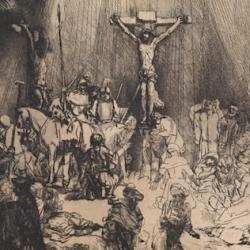A brief overview of key elements of the thought of Rene Girard.
Mimetic desire. Desire isn’t individual; it doesn’t emerge from isolated individuals. It’s mimetic. We desire what we see others desiring. This is the basis for the advertising industry; it’s obvious in any day care center, when children try to play with toys that other children are playing with; it’s evident in many of the romantic stories of Western literature (from Chaucer’s Knight’s Tale to Shakespeare and on).
Models, the Other. We desire mimetically, and that means that others become the models for our desires. We desire what our idols desire. We want to merge with them, to become one with them. We want to wear what they wear, like the beer and the cologne they wear.
Because desires is mimetic, it’s also rivalrous. If I want a woman because I see someone else wanting a woman, we’re going to get into a competition over her. If I desire a toy because another child wants the same toy, we’ll fight. Mimetic desire leads to rivalry, which also has a mimetic character: We mimic our rivals. And mimetic rivalry may lead to violence.
Specifically, mimetic desire and the rivalry it produces creates rivalry with the model. We want to be like the model, but this slips into a desire to replace the model, not to imitate but to become the model; not to merge with him in mutual love but to take his place.
This creates the complicated psychological dynamics that we have with our models. We admire and even worship them. They have a transcendent role. We want to mimic their every move and desire. We idolize them. We might even devise various forms of sacrifice to them; we can become abject before them. We may revel in their indifference and distance. Mimetic desire thus twists into masochism.
At the same time, we want to destroy them. They are obstacles in the way of our desires, and we can’t get what we want (ultimately, replacing the model) without getting rid of the model. We worship them, but we also hold them in contempt. When we try to destroy the model, though, we often fail. And in a sense we want this failure, because is confirms our original admiration.
Now, all of this is at the level of individual psychology and social interaction. It’s a powerful tool. But Girard also believes that mimetic desire and mimetic rivalry can explain the rise of the sacred.
Sacrificial crisis. Mimetic rivalries can become pervasive in a community. Everyone is a rival with everyone else, a war of all against all. This is the situation that Girard describes as a sacrificial crisis. Something has to be done to contain the violence that threatens to dissolve society.
Violence is expelled by violence. Satan casts out Satan. Social harmony is re-established when the violence of all against all is redirected toward a common object. It can be a person or group within the community that is marginal (immigrants; Oedipus, with his foreign origins and his club foot). It can be an outsider (wag the dog). We set up a scapegoat who will bear the violence of the whole society, and so deliver the society from dissolution in the sacrificial crisis.
Violence against the scapegoat becomes the source of myth. Myth is the obfuscation of the scapegoat mechanism, covering over reality by claiming that the scapegoat is guilty. In most myths, the scapegoat concedes his guilt and accepts his fate, sometimes voluntarily expelling himself from the community (Oedipus).
This is also the foundation of the sacred. The scapegoat is despised and cast out. But then the scapegoat’s expulsion is seen to heal and harmonize society. The rejected scapegoat is seen as savior and the people make monuments to the rejected scapegoat. He becomes a sacred person, and sacrifice re-enacts the harmonization of society by violence.
Over time, Girard became more and more aware of the revolutionary role that Christianity played in the history of the sacred.
Scapegoating depends on the mythical affirmation of the guilt of the victim. The Bible, though, insists on the scapegoat’s innocence. Jesus is innocent, and before Him Job and others protest their innocence.
The gospel punctures myth, which depends on the claim that the scapegoat was a contamination that had to be removed. It undermines the scapegoat mechanism, by making us self-conscious of scapegoating. It destroys the sacred by eliminating the violence that founded it.











